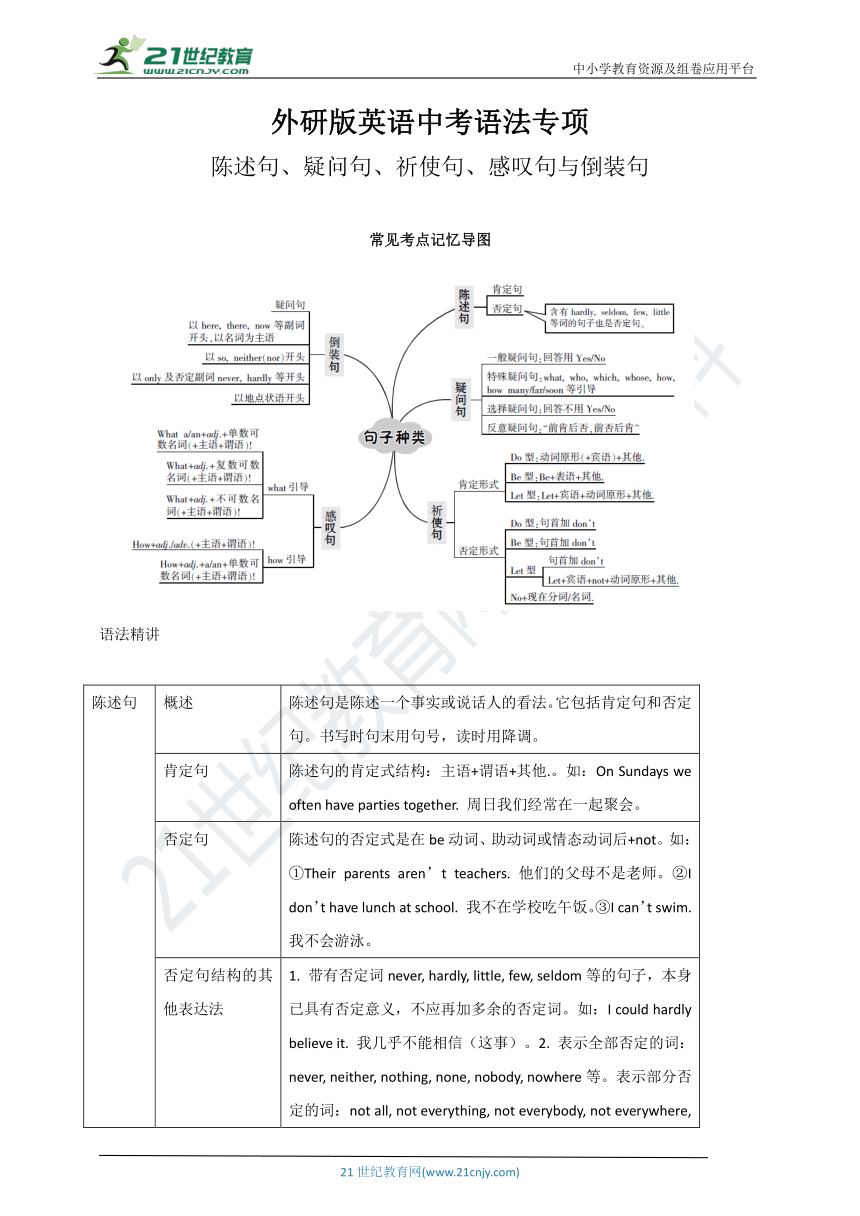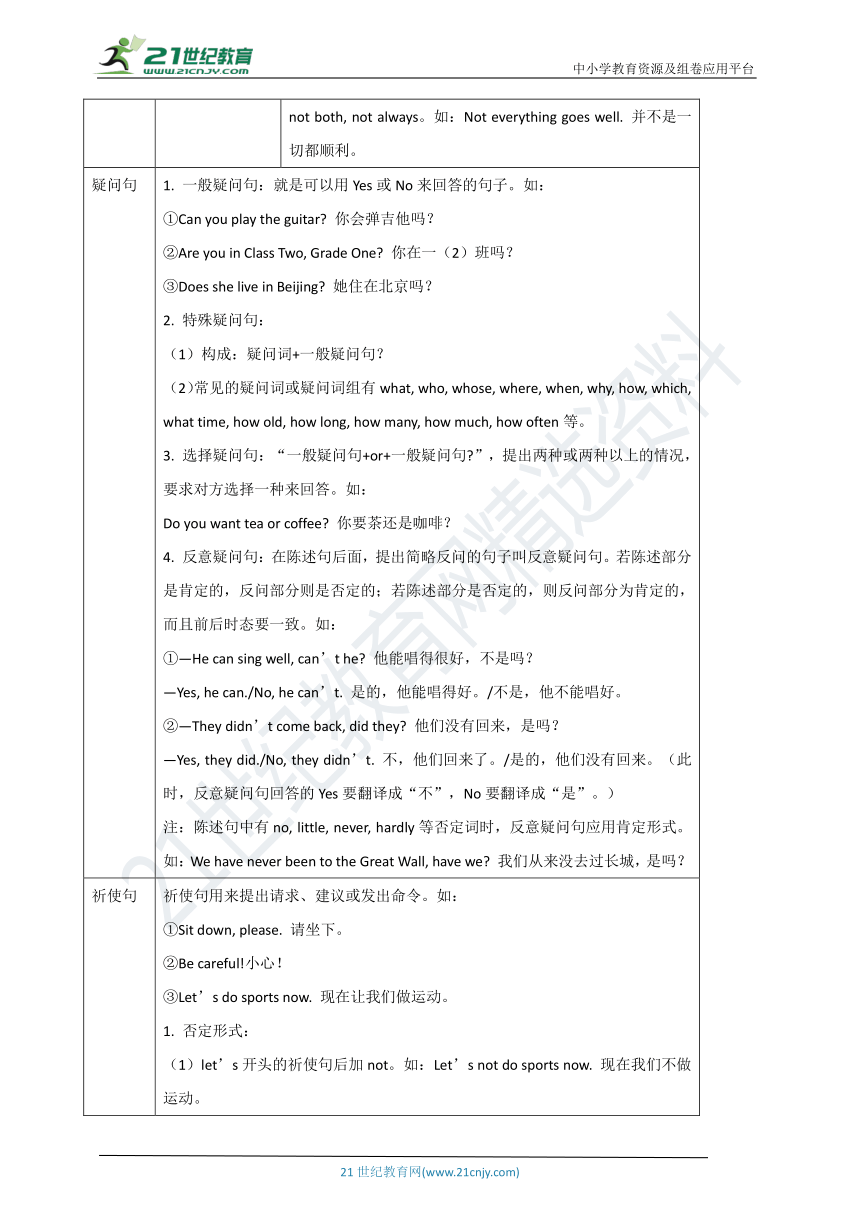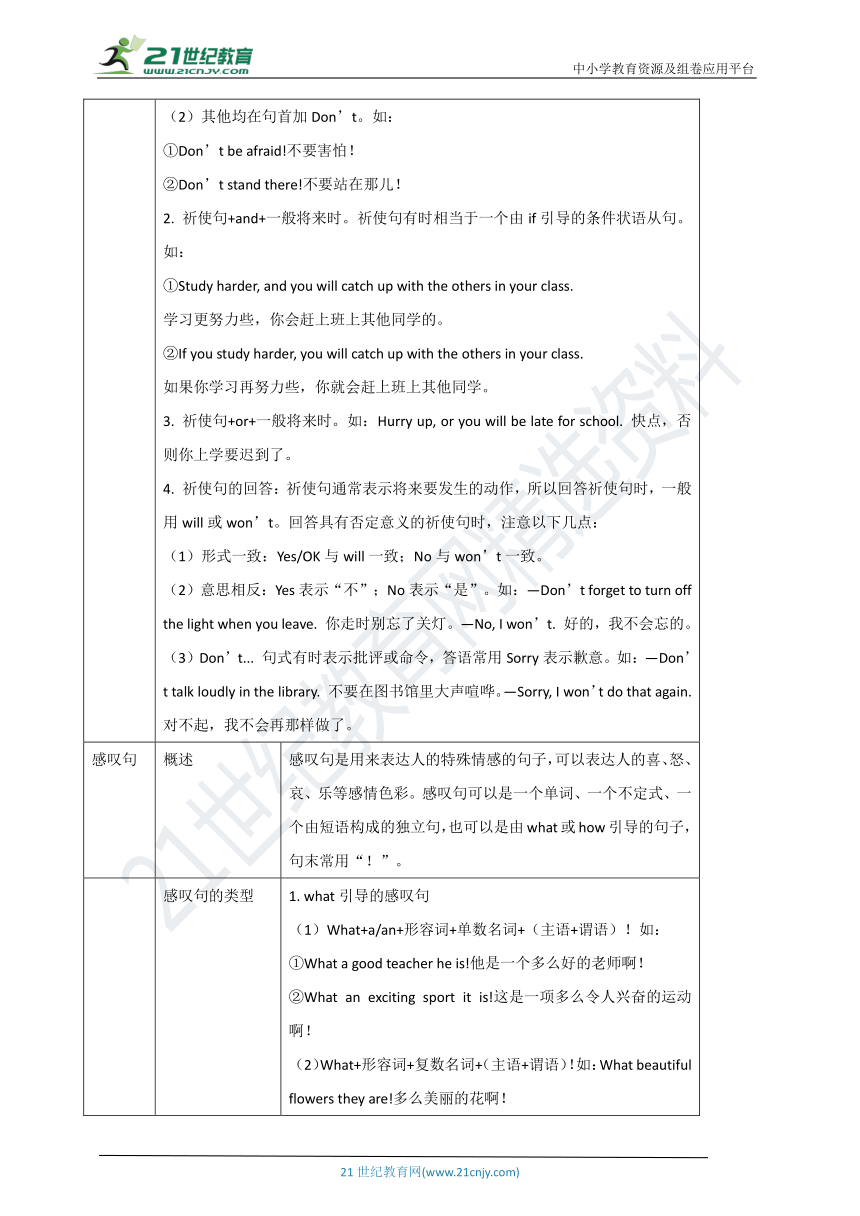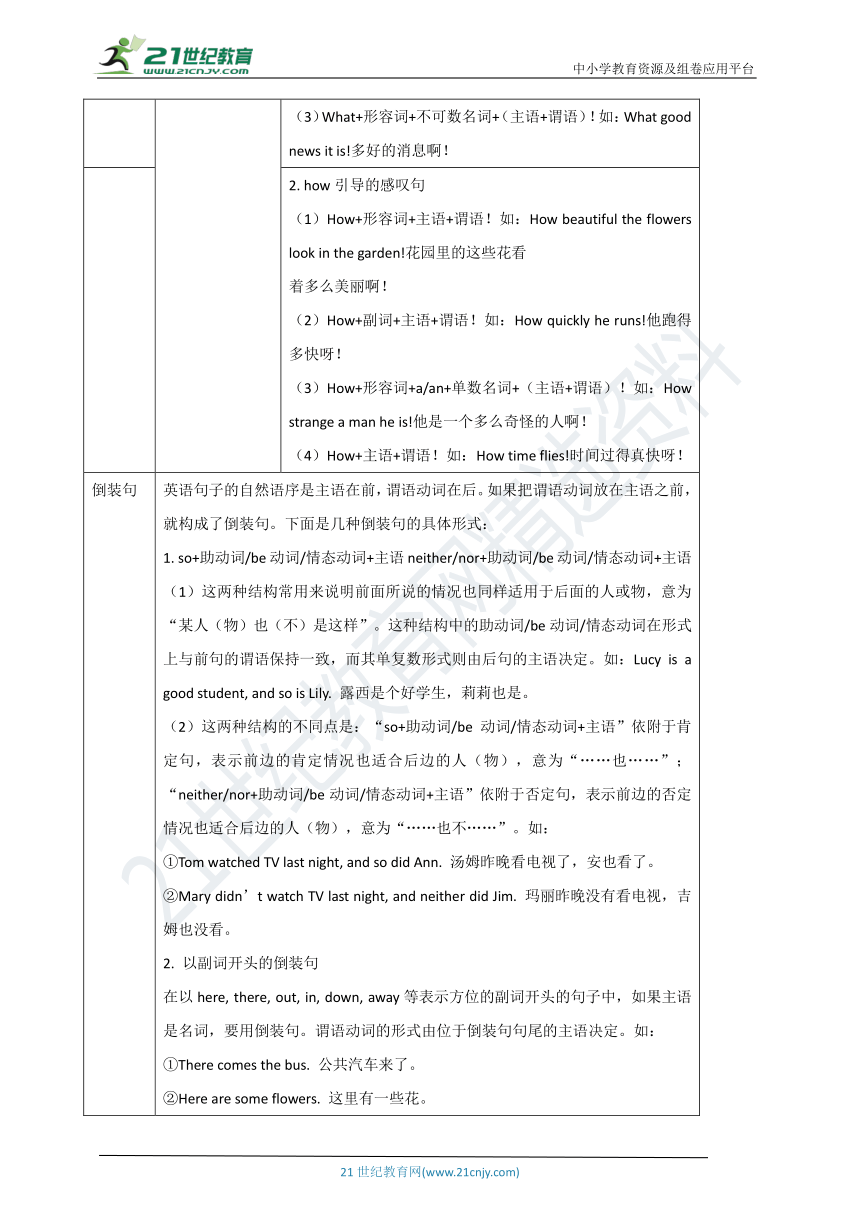外研版英语中考二轮语法专项—— 陈述句、疑问句、祈使句、感叹句与倒装句 知识梳理+实战演练(含答案)
文档属性
| 名称 | 外研版英语中考二轮语法专项—— 陈述句、疑问句、祈使句、感叹句与倒装句 知识梳理+实战演练(含答案) |

|
|
| 格式 | doc | ||
| 文件大小 | 1.4MB | ||
| 资源类型 | 试卷 | ||
| 版本资源 | 外研版 | ||
| 科目 | 英语 | ||
| 更新时间 | 2022-02-08 13:34:40 | ||
图片预览




文档简介
中小学教育资源及组卷应用平台
外研版英语中考语法专项
陈述句、疑问句、祈使句、感叹句与倒装句
常见考点记忆导图
语法精讲
陈述句 概述 陈述句是陈述一个事实或说话人的看法。它包括肯定句和否定句。书写时句末用句号,读时用降调。
肯定句 陈述句的肯定式结构:主语+谓语+其他.。如:On Sundays we often have parties together. 周日我们经常在一起聚会。
否定句 陈述句的否定式是在be动词、助动词或情态动词后+not。如:①Their parents aren’t teachers. 他们的父母不是老师。②I don’t have lunch at school. 我不在学校吃午饭。③I can’t swim. 我不会游泳。
否定句结构的其他表达法 1. 带有否定词never, hardly, little, few, seldom等的句子,本身已具有否定意义,不应再加多余的否定词。如:I could hardly believe it. 我几乎不能相信(这事)。2. 表示全部否定的词:never, neither, nothing, none, nobody, nowhere等。表示部分否定的词:not all, not everything, not everybody, not everywhere, not both, not always。如:Not everything goes well. 并不是一切都顺利。
疑问句 1. 一般疑问句:就是可以用Yes或No来回答的句子。如:①Can you play the guitar 你会弹吉他吗?②Are you in Class Two, Grade One 你在一(2)班吗?③Does she live in Beijing 她住在北京吗?2. 特殊疑问句:(1)构成:疑问词+一般疑问句?(2)常见的疑问词或疑问词组有what, who, whose, where, when, why, how, which, what time, how old, how long, how many, how much, how often等。3. 选择疑问句:“一般疑问句+or+一般疑问句 ”,提出两种或两种以上的情况,要求对方选择一种来回答。如:Do you want tea or coffee 你要茶还是咖啡?4. 反意疑问句:在陈述句后面,提出简略反问的句子叫反意疑问句。若陈述部分是肯定的,反问部分则是否定的;若陈述部分是否定的,则反问部分为肯定的,而且前后时态要一致。如:①—He can sing well, can’t he 他能唱得很好,不是吗?—Yes, he can./No, he can’t. 是的,他能唱得好。/不是,他不能唱好。②—They didn’t come back, did they 他们没有回来,是吗?—Yes, they did./No, they didn’t. 不,他们回来了。/是的,他们没有回来。(此时,反意疑问句回答的Yes要翻译成“不”,No要翻译成“是”。)注:陈述句中有no, little, never, hardly等否定词时,反意疑问句应用肯定形式。如:We have never been to the Great Wall, have we 我们从来没去过长城,是吗?
祈使句 祈使句用来提出请求、建议或发出命令。如:①Sit down, please. 请坐下。②Be careful!小心!③Let’s do sports now. 现在让我们做运动。1. 否定形式:(1)let’s开头的祈使句后加not。如:Let’s not do sports now. 现在我们不做运动。(2)其他均在句首加Don’t。如:①Don’t be afraid!不要害怕!②Don’t stand there!不要站在那儿!2. 祈使句+and+一般将来时。祈使句有时相当于一个由if引导的条件状语从句。如:①Study harder, and you will catch up with the others in your class. 学习更努力些,你会赶上班上其他同学的。②If you study harder, you will catch up with the others in your class. 如果你学习再努力些,你就会赶上班上其他同学。3. 祈使句+or+一般将来时。如:Hurry up, or you will be late for school. 快点,否则你上学要迟到了。4. 祈使句的回答:祈使句通常表示将来要发生的动作,所以回答祈使句时,一般用will或won’t。回答具有否定意义的祈使句时,注意以下几点:(1)形式一致:Yes/OK与will一致;No与won’t一致。(2)意思相反:Yes表示“不”;No表示“是”。如:—Don’t forget to turn off the light when you leave. 你走时别忘了关灯。—No, I won’t. 好的,我不会忘的。(3)Don’t... 句式有时表示批评或命令,答语常用Sorry表示歉意。如:—Don’t talk loudly in the library. 不要在图书馆里大声喧哗。—Sorry, I won’t do that again. 对不起,我不会再那样做了。
感叹句 概述 感叹句是用来表达人的特殊情感的句子,可以表达人的喜、怒、哀、乐等感彩。感叹句可以是一个单词、一个不定式、一个由短语构成的独立句,也可以是由what或how引导的句子,句末常用“!”。
感叹句的类型 1. what引导的感叹句(1)What+a/an+形容词+单数名词+(主语+谓语)!如:①What a good teacher he is!他是一个多么好的老师啊!②What an exciting sport it is!这是一项多么令人兴奋的运动啊!(2)What+形容词+复数名词+(主语+谓语)!如:What beautiful flowers they are!多么美丽的花啊!(3)What+形容词+不可数名词+(主语+谓语)!如:What good news it is!多好的消息啊!
2. how引导的感叹句(1)How+形容词+主语+谓语!如:How beautiful the flowers look in the garden!花园里的这些花看着多么美丽啊!(2)How+副词+主语+谓语!如:How quickly he runs!他跑得多快呀!(3)How+形容词+a/an+单数名词+(主语+谓语)!如:How strange a man he is!他是一个多么奇怪的人啊!(4)How+主语+谓语!如:How time flies!时间过得真快呀!
倒装句 英语句子的自然语序是主语在前,谓语动词在后。如果把谓语动词放在主语之前,就构成了倒装句。下面是几种倒装句的具体形式:1. so+助动词/be动词/情态动词+主语neither/nor+助动词/be动词/情态动词+主语(1)这两种结构常用来说明前面所说的情况也同样适用于后面的人或物,意为“某人(物)也(不)是这样”。这种结构中的助动词/be动词/情态动词在形式上与前句的谓语保持一致,而其单复数形式则由后句的主语决定。如:Lucy is a good student, and so is Lily. 露西是个好学生,莉莉也是。(2)这两种结构的不同点是:“so+助动词/be动词/情态动词+主语”依附于肯定句,表示前边的肯定情况也适合后边的人(物),意为“……也……”;“neither/nor+助动词/be动词/情态动词+主语”依附于否定句,表示前边的否定情况也适合后边的人(物),意为“……也不……”。如:①Tom watched TV last night, and so did Ann. 汤姆昨晚看电视了,安也看了。②Mary didn’t watch TV last night, and neither did Jim. 玛丽昨晚没有看电视,吉姆也没看。2. 以副词开头的倒装句在以here, there, out, in, down, away等表示方位的副词开头的句子中,如果主语是名词,要用倒装句。谓语动词的形式由位于倒装句句尾的主语决定。如:①There comes the bus. 公共汽车来了。②Here are some flowers. 这里有一些花。注:如果主语是人称代词,就不必倒装。如:①Here you are. 给你。②Here it is. 在这里呢。
实战演练
一、根据句意完成下列句子
1. (宁波中考)I don’t think many of us realize______________ lucky we are.
2. You must think about______________ should be done first.
3. —Hello, Jack!Haven’t seen you for long!I’m calling to check______________ you are.
—Very well. Thanks.
4. —Do you know______________ he exercised when he was a student
—Three or four times a week.
5. —Do you know______________ he is going to stay in London
—Sorry, I don’t know. Maybe a few weeks, but I’m not sure.
6. (嘉兴、舟山中考)They were surprised well the small cat seemed to get along with the large bear.
7. She came to realize______________ she actually missed all of them.
8. —______________ are you always staying up so late these days
—To prepare for my final exams.
9. The robot can help me sweep the floor. smart invention it is!
10. Look! Laura is going to finish in first place.______________ fast she runs!
二、根据句意或汉语提示完成祈使句或倒装句
1.______________ wake up your sister, Ben. She needs a good sleep.
2.______________ (努力学习),______________ (否则你不会) pass the exam.
3.______________ (驾驶) carefully, Michael! There’s a school ahead.
4. Tree-planting Day is coming.______________ (让我们) grow some trees over there.
5. —Tom has been to China before.
—____________________________ (也去过) Mike.
6. —He continued watching TV after the phone rang many times.
—____________________________ (的确如此).
7. —Li Ping wasn’t late for school this morning.
—____________________________ (也没有) Tom.
三、根据句意或要求完成句子
1. —______________ can you finish the report on food safety
—In two days.
2. —She doesn’t like pop music,______________
—No, she doesn’t.
3. (重庆中考B卷)My aunt likes watching TV plays. (改为否定句)
My aunt____________________________ watching TV plays.
4. John runs very fast. No one can catch up with him in his class. (合并为一个句子)
John runs______________ fast______________ no one can catch up with him in his class.
5. Let’s discuss how can we get to the airport. (改为简单句)
Let’s discuss____________________________ get to the airport.
参考答案
第35课 陈述句、疑问句、祈使句、感叹句与倒装句
实战演练
一、1. how 2. what 3. how 4. how often 5. how long
6. how 7. how much 8. Why 9. What a 10. How
二、1. Don’t 2. Study hard, or you won’t 3. Drive 4. Let’s
5. So has 6. So he did 7. Neither was
三、1. How soon 2. does she 3. doesn’t like 4. so, that
5. how to
21世纪教育网 www.21cnjy.com 精品试卷·第 2 页 (共 2 页)
HYPERLINK "http://21世纪教育网(www.21cnjy.com)
" 21世纪教育网(www.21cnjy.com)
外研版英语中考语法专项
陈述句、疑问句、祈使句、感叹句与倒装句
常见考点记忆导图
语法精讲
陈述句 概述 陈述句是陈述一个事实或说话人的看法。它包括肯定句和否定句。书写时句末用句号,读时用降调。
肯定句 陈述句的肯定式结构:主语+谓语+其他.。如:On Sundays we often have parties together. 周日我们经常在一起聚会。
否定句 陈述句的否定式是在be动词、助动词或情态动词后+not。如:①Their parents aren’t teachers. 他们的父母不是老师。②I don’t have lunch at school. 我不在学校吃午饭。③I can’t swim. 我不会游泳。
否定句结构的其他表达法 1. 带有否定词never, hardly, little, few, seldom等的句子,本身已具有否定意义,不应再加多余的否定词。如:I could hardly believe it. 我几乎不能相信(这事)。2. 表示全部否定的词:never, neither, nothing, none, nobody, nowhere等。表示部分否定的词:not all, not everything, not everybody, not everywhere, not both, not always。如:Not everything goes well. 并不是一切都顺利。
疑问句 1. 一般疑问句:就是可以用Yes或No来回答的句子。如:①Can you play the guitar 你会弹吉他吗?②Are you in Class Two, Grade One 你在一(2)班吗?③Does she live in Beijing 她住在北京吗?2. 特殊疑问句:(1)构成:疑问词+一般疑问句?(2)常见的疑问词或疑问词组有what, who, whose, where, when, why, how, which, what time, how old, how long, how many, how much, how often等。3. 选择疑问句:“一般疑问句+or+一般疑问句 ”,提出两种或两种以上的情况,要求对方选择一种来回答。如:Do you want tea or coffee 你要茶还是咖啡?4. 反意疑问句:在陈述句后面,提出简略反问的句子叫反意疑问句。若陈述部分是肯定的,反问部分则是否定的;若陈述部分是否定的,则反问部分为肯定的,而且前后时态要一致。如:①—He can sing well, can’t he 他能唱得很好,不是吗?—Yes, he can./No, he can’t. 是的,他能唱得好。/不是,他不能唱好。②—They didn’t come back, did they 他们没有回来,是吗?—Yes, they did./No, they didn’t. 不,他们回来了。/是的,他们没有回来。(此时,反意疑问句回答的Yes要翻译成“不”,No要翻译成“是”。)注:陈述句中有no, little, never, hardly等否定词时,反意疑问句应用肯定形式。如:We have never been to the Great Wall, have we 我们从来没去过长城,是吗?
祈使句 祈使句用来提出请求、建议或发出命令。如:①Sit down, please. 请坐下。②Be careful!小心!③Let’s do sports now. 现在让我们做运动。1. 否定形式:(1)let’s开头的祈使句后加not。如:Let’s not do sports now. 现在我们不做运动。(2)其他均在句首加Don’t。如:①Don’t be afraid!不要害怕!②Don’t stand there!不要站在那儿!2. 祈使句+and+一般将来时。祈使句有时相当于一个由if引导的条件状语从句。如:①Study harder, and you will catch up with the others in your class. 学习更努力些,你会赶上班上其他同学的。②If you study harder, you will catch up with the others in your class. 如果你学习再努力些,你就会赶上班上其他同学。3. 祈使句+or+一般将来时。如:Hurry up, or you will be late for school. 快点,否则你上学要迟到了。4. 祈使句的回答:祈使句通常表示将来要发生的动作,所以回答祈使句时,一般用will或won’t。回答具有否定意义的祈使句时,注意以下几点:(1)形式一致:Yes/OK与will一致;No与won’t一致。(2)意思相反:Yes表示“不”;No表示“是”。如:—Don’t forget to turn off the light when you leave. 你走时别忘了关灯。—No, I won’t. 好的,我不会忘的。(3)Don’t... 句式有时表示批评或命令,答语常用Sorry表示歉意。如:—Don’t talk loudly in the library. 不要在图书馆里大声喧哗。—Sorry, I won’t do that again. 对不起,我不会再那样做了。
感叹句 概述 感叹句是用来表达人的特殊情感的句子,可以表达人的喜、怒、哀、乐等感彩。感叹句可以是一个单词、一个不定式、一个由短语构成的独立句,也可以是由what或how引导的句子,句末常用“!”。
感叹句的类型 1. what引导的感叹句(1)What+a/an+形容词+单数名词+(主语+谓语)!如:①What a good teacher he is!他是一个多么好的老师啊!②What an exciting sport it is!这是一项多么令人兴奋的运动啊!(2)What+形容词+复数名词+(主语+谓语)!如:What beautiful flowers they are!多么美丽的花啊!(3)What+形容词+不可数名词+(主语+谓语)!如:What good news it is!多好的消息啊!
2. how引导的感叹句(1)How+形容词+主语+谓语!如:How beautiful the flowers look in the garden!花园里的这些花看着多么美丽啊!(2)How+副词+主语+谓语!如:How quickly he runs!他跑得多快呀!(3)How+形容词+a/an+单数名词+(主语+谓语)!如:How strange a man he is!他是一个多么奇怪的人啊!(4)How+主语+谓语!如:How time flies!时间过得真快呀!
倒装句 英语句子的自然语序是主语在前,谓语动词在后。如果把谓语动词放在主语之前,就构成了倒装句。下面是几种倒装句的具体形式:1. so+助动词/be动词/情态动词+主语neither/nor+助动词/be动词/情态动词+主语(1)这两种结构常用来说明前面所说的情况也同样适用于后面的人或物,意为“某人(物)也(不)是这样”。这种结构中的助动词/be动词/情态动词在形式上与前句的谓语保持一致,而其单复数形式则由后句的主语决定。如:Lucy is a good student, and so is Lily. 露西是个好学生,莉莉也是。(2)这两种结构的不同点是:“so+助动词/be动词/情态动词+主语”依附于肯定句,表示前边的肯定情况也适合后边的人(物),意为“……也……”;“neither/nor+助动词/be动词/情态动词+主语”依附于否定句,表示前边的否定情况也适合后边的人(物),意为“……也不……”。如:①Tom watched TV last night, and so did Ann. 汤姆昨晚看电视了,安也看了。②Mary didn’t watch TV last night, and neither did Jim. 玛丽昨晚没有看电视,吉姆也没看。2. 以副词开头的倒装句在以here, there, out, in, down, away等表示方位的副词开头的句子中,如果主语是名词,要用倒装句。谓语动词的形式由位于倒装句句尾的主语决定。如:①There comes the bus. 公共汽车来了。②Here are some flowers. 这里有一些花。注:如果主语是人称代词,就不必倒装。如:①Here you are. 给你。②Here it is. 在这里呢。
实战演练
一、根据句意完成下列句子
1. (宁波中考)I don’t think many of us realize______________ lucky we are.
2. You must think about______________ should be done first.
3. —Hello, Jack!Haven’t seen you for long!I’m calling to check______________ you are.
—Very well. Thanks.
4. —Do you know______________ he exercised when he was a student
—Three or four times a week.
5. —Do you know______________ he is going to stay in London
—Sorry, I don’t know. Maybe a few weeks, but I’m not sure.
6. (嘉兴、舟山中考)They were surprised well the small cat seemed to get along with the large bear.
7. She came to realize______________ she actually missed all of them.
8. —______________ are you always staying up so late these days
—To prepare for my final exams.
9. The robot can help me sweep the floor. smart invention it is!
10. Look! Laura is going to finish in first place.______________ fast she runs!
二、根据句意或汉语提示完成祈使句或倒装句
1.______________ wake up your sister, Ben. She needs a good sleep.
2.______________ (努力学习),______________ (否则你不会) pass the exam.
3.______________ (驾驶) carefully, Michael! There’s a school ahead.
4. Tree-planting Day is coming.______________ (让我们) grow some trees over there.
5. —Tom has been to China before.
—____________________________ (也去过) Mike.
6. —He continued watching TV after the phone rang many times.
—____________________________ (的确如此).
7. —Li Ping wasn’t late for school this morning.
—____________________________ (也没有) Tom.
三、根据句意或要求完成句子
1. —______________ can you finish the report on food safety
—In two days.
2. —She doesn’t like pop music,______________
—No, she doesn’t.
3. (重庆中考B卷)My aunt likes watching TV plays. (改为否定句)
My aunt____________________________ watching TV plays.
4. John runs very fast. No one can catch up with him in his class. (合并为一个句子)
John runs______________ fast______________ no one can catch up with him in his class.
5. Let’s discuss how can we get to the airport. (改为简单句)
Let’s discuss____________________________ get to the airport.
参考答案
第35课 陈述句、疑问句、祈使句、感叹句与倒装句
实战演练
一、1. how 2. what 3. how 4. how often 5. how long
6. how 7. how much 8. Why 9. What a 10. How
二、1. Don’t 2. Study hard, or you won’t 3. Drive 4. Let’s
5. So has 6. So he did 7. Neither was
三、1. How soon 2. does she 3. doesn’t like 4. so, that
5. how to
21世纪教育网 www.21cnjy.com 精品试卷·第 2 页 (共 2 页)
HYPERLINK "http://21世纪教育网(www.21cnjy.com)
" 21世纪教育网(www.21cnjy.com)
同课章节目录
- 词法
- 名词
- 动词和动词短语
- 动词语态
- 动词时态
- 助动词和情态动词
- 非谓语动词
- 冠词
- 代词
- 数词和量词
- 形容词副词及其比较等级
- 介词和介词短语
- 连词和感叹词
- 构词法
- 相似、相近词比较
- 句法
- 陈述句
- 一般疑问句和否定疑问句
- 特殊疑问句及选择疑问句
- 反意疑问句
- 存在句(There be句型)
- 宾语从句
- 定语从句
- 状语从句
- 主谓一致问题
- 简单句
- 并列句
- 复合句
- 主谓一致
- 主、表语从句
- 名词性从句
- 直接引语和间接引语
- 虚拟语气
- 感叹句
- 强调句
- 倒装句
- 祈使句
- 句子的成分
- 句子的分类
- 题型专区
- 单项选择部分
- 易错题
- 完形填空
- 阅读理解
- 词汇练习
- 听说训练
- 句型转换
- 补全对话
- 短文改错
- 翻译
- 书面表达
- 任务型阅读
- 语法填空
- 其他资料
